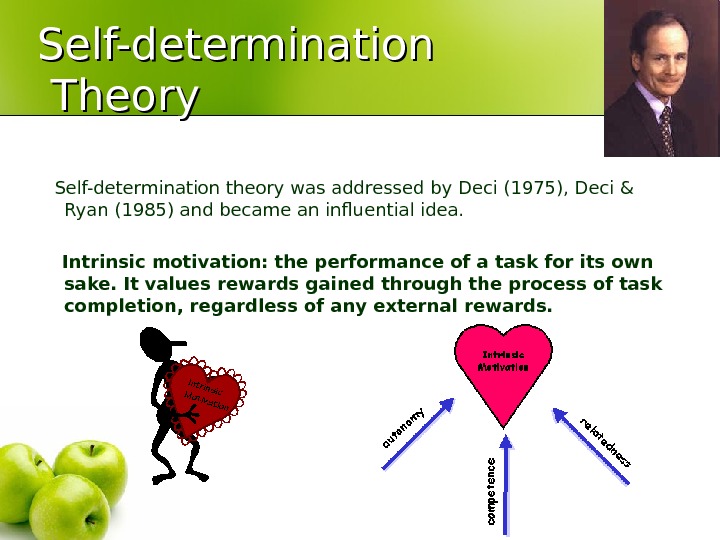Types of Motivation Definitions of motivation



























types_of_motivation_dana_kabylbekova.ppt
- Размер: 1.3 Mегабайта
- Количество слайдов: 26
Описание презентации Types of Motivation Definitions of motivation по слайдам
 Types of Motivation
Types of Motivation
 Definitions of motivation Why do people learn a second language? Good L 2 learners Theories of motivation Factors that affect motivation Implications and strategies for teachers Contents
Definitions of motivation Why do people learn a second language? Good L 2 learners Theories of motivation Factors that affect motivation Implications and strategies for teachers Contents
 “ I don’t know what motivation is but it definitely keeps me going. ”
“ I don’t know what motivation is but it definitely keeps me going. ”

 Motivation is a desire to achieve a goal, combined with the energy to work towards that goal. Students who are motivated have a desire to undertake their study and complete the requirements of their course.
Motivation is a desire to achieve a goal, combined with the energy to work towards that goal. Students who are motivated have a desire to undertake their study and complete the requirements of their course.
 motivation is a set of energetic forces that originate both within as well as beyond an individual’s being, to initiate behavior, and to determine its form, direction, intensity, and duration. ”
motivation is a set of energetic forces that originate both within as well as beyond an individual’s being, to initiate behavior, and to determine its form, direction, intensity, and duration. ”
 Why do people learn foreign language? Here a few suggestions: Fulfill school/university requirements Function and compete effectively in the global economy of today and the future Increase job opportunities and salary potential Develop intercultural sensitivity, increasing global understanding Improve English vocabulary and language proficiency in order to communicate with members of that language community. Improve one’s education Enhance travel and study abroad opportunities Enjoy great literary and musical masterpieces and films in their original language Improve likelihood of acceptance into university and graduate schools Gain social power (prestige) Please one’s parents After all, we, as teachers, need to find the student’s motives so that we can accommodate them.
Why do people learn foreign language? Here a few suggestions: Fulfill school/university requirements Function and compete effectively in the global economy of today and the future Increase job opportunities and salary potential Develop intercultural sensitivity, increasing global understanding Improve English vocabulary and language proficiency in order to communicate with members of that language community. Improve one’s education Enhance travel and study abroad opportunities Enjoy great literary and musical masterpieces and films in their original language Improve likelihood of acceptance into university and graduate schools Gain social power (prestige) Please one’s parents After all, we, as teachers, need to find the student’s motives so that we can accommodate them.
 Good L 2 learners Research has shown that the use of specific learning strategies & techniques while studying a second or foreign language leads to success. «The conscious, tailored use of such strategies is related to language achievement and proficiency. (Oxford, 1994) Rubin (1975) suggested that good L 2 learners are willing and accurate guessers; have a strong drive to communicate; are often uninhibited, and if they are, they combat inhibition by using positive self-talk, by extensive use of practicing in private, and by putting themselves in situations where they have to participate communicatively. are willing to make mistakes; focus on form by looking for patterns and analyzing; take advantage of all practice opportunities; monitor their speech as well as that of others; and pay attention to meaning.
Good L 2 learners Research has shown that the use of specific learning strategies & techniques while studying a second or foreign language leads to success. «The conscious, tailored use of such strategies is related to language achievement and proficiency. (Oxford, 1994) Rubin (1975) suggested that good L 2 learners are willing and accurate guessers; have a strong drive to communicate; are often uninhibited, and if they are, they combat inhibition by using positive self-talk, by extensive use of practicing in private, and by putting themselves in situations where they have to participate communicatively. are willing to make mistakes; focus on form by looking for patterns and analyzing; take advantage of all practice opportunities; monitor their speech as well as that of others; and pay attention to meaning.
 Theories of Motivation Gardner and Lambert proposed integrative motivation and instrumental motivation from a social psychological point of view. (Gardner and Lambert 1959, 1972) 1. Integrative motivation: aim of learning is to learn about the language group, or to meet more and different people from the target language community, to the point of eventually being accepted as a member of that group. 2. Instrumental motivation: reasons of L 2 learning reflect the more utilitarian value of linguistic achievement, such as benefiting in an occupation.
Theories of Motivation Gardner and Lambert proposed integrative motivation and instrumental motivation from a social psychological point of view. (Gardner and Lambert 1959, 1972) 1. Integrative motivation: aim of learning is to learn about the language group, or to meet more and different people from the target language community, to the point of eventually being accepted as a member of that group. 2. Instrumental motivation: reasons of L 2 learning reflect the more utilitarian value of linguistic achievement, such as benefiting in an occupation.
 Self-determination Theory Self-determination theory was addressed by Deci (1975), Deci & Ryan (1985) and became an influential idea. Intrinsic motivation: the performance of a task for its own sake. It values rewards gained through the process of task completion, regardless of any external rewards.
Self-determination Theory Self-determination theory was addressed by Deci (1975), Deci & Ryan (1985) and became an influential idea. Intrinsic motivation: the performance of a task for its own sake. It values rewards gained through the process of task completion, regardless of any external rewards.
 Extrinsic motivation: an inner drive, impulse, emotion, or desire that is derived from other people, or the real world. e. g. learn L 2 for money, prizes, grades, certain types of positive feedback Also, it should be noted that, the self-determination theory evolved to the popular concept of “ learner autonomy ”. Its relation with motivation is gathering attention. (Benson, 2000; Ushioda, 1996, 1998, 2007; Ehrman and Dörnyei, 1998)
Extrinsic motivation: an inner drive, impulse, emotion, or desire that is derived from other people, or the real world. e. g. learn L 2 for money, prizes, grades, certain types of positive feedback Also, it should be noted that, the self-determination theory evolved to the popular concept of “ learner autonomy ”. Its relation with motivation is gathering attention. (Benson, 2000; Ushioda, 1996, 1998, 2007; Ehrman and Dörnyei, 1998)

 Factors that affect motivation «Motivation to learn is a competence acquired through general experience but stimulated most directly through modeling , communication of expectations , and direct instruction or socialization by significant others (especially parents and teachers). » (Brophy, 1987) «To a very large degree, students expect to learn if their teachers expect them to learn. » (Stipek, 1988) Several factors affect students’ motivation to learn a second language. .
Factors that affect motivation «Motivation to learn is a competence acquired through general experience but stimulated most directly through modeling , communication of expectations , and direct instruction or socialization by significant others (especially parents and teachers). » (Brophy, 1987) «To a very large degree, students expect to learn if their teachers expect them to learn. » (Stipek, 1988) Several factors affect students’ motivation to learn a second language. .
 Internal Factors Age Gender Religion Goals Interest/curiosity Attitude Expectancy Competence Native language proficiency
Internal Factors Age Gender Religion Goals Interest/curiosity Attitude Expectancy Competence Native language proficiency
 External Factors Teachers Encouragement Expectations Feedback Scaffolding Task presentation Teaching strategies & techniques Rewards
External Factors Teachers Encouragement Expectations Feedback Scaffolding Task presentation Teaching strategies & techniques Rewards
 Course content & Classroom atmosphere Relevance Attractiveness Challenge Relaxed, positive atmosphere (low affective filter)
Course content & Classroom atmosphere Relevance Attractiveness Challenge Relaxed, positive atmosphere (low affective filter)
 Social Identity (Peer groups) Teenagers tend to be heavily influenced by their peer groups. In second language learning, peer pressure often undermines the goals set by parents and teachers. Peer pressure often reduces the desire of the student to work toward native pronunciation, because the sounds of the target language may be regarded as strange. For learners of English as a second language, speaking like a native speaker may unconsciously be regarded as a sign of no longer belonging to their native-language peer group. In working with secondary school students, it is important to keep these peer influences in mind and to foster a positive image for proficiency in a second language.
Social Identity (Peer groups) Teenagers tend to be heavily influenced by their peer groups. In second language learning, peer pressure often undermines the goals set by parents and teachers. Peer pressure often reduces the desire of the student to work toward native pronunciation, because the sounds of the target language may be regarded as strange. For learners of English as a second language, speaking like a native speaker may unconsciously be regarded as a sign of no longer belonging to their native-language peer group. In working with secondary school students, it is important to keep these peer influences in mind and to foster a positive image for proficiency in a second language.
 Home support Support from home is very important for students’ motivation to learn a second language. If parents value both the native language and English, communicate with their children in whichever language is most comfortable, and show support for and interest in their children’s progress, the children will definitely be more motivated to learn the second language. Learning environment In order for the students to be motivated, the learning environment needs to be free from a n xiety; the student should not feel threatened or intimidated. In order for him/her to speak, s/he needs to feel s/he will be heard and that what s/he is saying is worth hearing.
Home support Support from home is very important for students’ motivation to learn a second language. If parents value both the native language and English, communicate with their children in whichever language is most comfortable, and show support for and interest in their children’s progress, the children will definitely be more motivated to learn the second language. Learning environment In order for the students to be motivated, the learning environment needs to be free from a n xiety; the student should not feel threatened or intimidated. In order for him/her to speak, s/he needs to feel s/he will be heard and that what s/he is saying is worth hearing.
 Implications and Strategies for Teachers Some teaching strategies that can be used to foster motivation and provide better transfer opportunities of language skills include the following: (Ngeow, Karen Yeok-Hwa, 1998) * Encourage learners to take ownership in learning. Have learners take ownership of the learning assignment by letting them identify and decide for themselves relevant learning goals. This will motivate them to apply what they have learned to attain these learning goals. * Promote intentional cognition or mindfulness to learning in various contexts. Learners must be able to practice language in multiple contexts in order to bridge domains and foster active abstraction of concepts learned (Bransford, et al. 1990). This will help learners recognize the relevance and transferability of different learning skills or knowledge. * Increase authenticity of learning tasks and goals. Learners should recognize a real need to accomplish learning goals that are relevant and holistic (rather than task-specific). This prepares them for the complexities of real-world tasks that require them to use language skills and knowledge that have to be continually transferred.
Implications and Strategies for Teachers Some teaching strategies that can be used to foster motivation and provide better transfer opportunities of language skills include the following: (Ngeow, Karen Yeok-Hwa, 1998) * Encourage learners to take ownership in learning. Have learners take ownership of the learning assignment by letting them identify and decide for themselves relevant learning goals. This will motivate them to apply what they have learned to attain these learning goals. * Promote intentional cognition or mindfulness to learning in various contexts. Learners must be able to practice language in multiple contexts in order to bridge domains and foster active abstraction of concepts learned (Bransford, et al. 1990). This will help learners recognize the relevance and transferability of different learning skills or knowledge. * Increase authenticity of learning tasks and goals. Learners should recognize a real need to accomplish learning goals that are relevant and holistic (rather than task-specific). This prepares them for the complexities of real-world tasks that require them to use language skills and knowledge that have to be continually transferred.
 «The best way to create interest in a subject is to render it worth knowing, which means to make the knowledge gained usable in one’s thinking beyond the situation in which learning has occurred. » Bruner (1960, p. 31)
«The best way to create interest in a subject is to render it worth knowing, which means to make the knowledge gained usable in one’s thinking beyond the situation in which learning has occurred. » Bruner (1960, p. 31)
 Oxford & Shearin (1996: 139) also offer Practical Suggestions for Teachers: 1. Teachers can identify why students are studying the new language. Teachers can find out actual motivations (motivation survey). Information on motivation can be passed on to the next class in a portfolio. Teachers can determine which parts of L 2 learning are especially valuable for the students. 2. Teachers can help shape students’ beliefs about success and failure in L 2 learning. Students can learn to have realistic but challenging goals. Teachers can learn to accept diversity in the way students establish and meet their goals, based on differences in learning styles. 3. Teachers can help students improve motivation by showing that L 2 learning can be an exciting mental challenge, a career enhancer, a vehicle to cultural awareness and friendship and a key to world peace. 4. Teachers can make the L 2 classroom a welcoming, positive place where psychological needs are met and where language anxiety is kept to a minimum. 5. Teachers can urge students to develop their own intrinsic rewards through positive self-talk, guided self-evaluation, and mastery of specific goals, rather than comparison with other students. Teachers can thus promote a sense of greater self-efficacy, increasing motivation to continue learning the L 2.
Oxford & Shearin (1996: 139) also offer Practical Suggestions for Teachers: 1. Teachers can identify why students are studying the new language. Teachers can find out actual motivations (motivation survey). Information on motivation can be passed on to the next class in a portfolio. Teachers can determine which parts of L 2 learning are especially valuable for the students. 2. Teachers can help shape students’ beliefs about success and failure in L 2 learning. Students can learn to have realistic but challenging goals. Teachers can learn to accept diversity in the way students establish and meet their goals, based on differences in learning styles. 3. Teachers can help students improve motivation by showing that L 2 learning can be an exciting mental challenge, a career enhancer, a vehicle to cultural awareness and friendship and a key to world peace. 4. Teachers can make the L 2 classroom a welcoming, positive place where psychological needs are met and where language anxiety is kept to a minimum. 5. Teachers can urge students to develop their own intrinsic rewards through positive self-talk, guided self-evaluation, and mastery of specific goals, rather than comparison with other students. Teachers can thus promote a sense of greater self-efficacy, increasing motivation to continue learning the L 2.

 Motivated students (and children) are, to teachers (and parents) precious commodities to be cherished. A motivated student (child) is more likely to learn.
Motivated students (and children) are, to teachers (and parents) precious commodities to be cherished. A motivated student (child) is more likely to learn.




